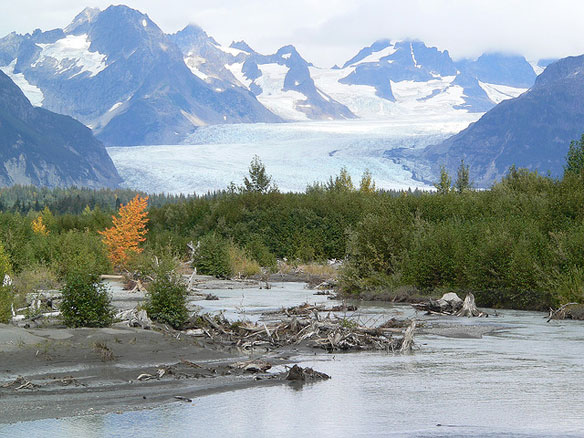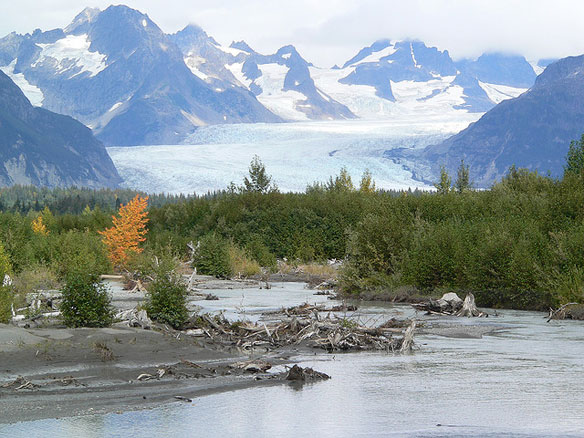
Pebble Mine would be located 200 miles southwest of Anchorage and has been described as the potentially the world’s largest man-made excavation… “Imagine a pit two miles wide by 2,000 feet deep, and an underground mine a mile deep. This gargantuan gold and copper operation would produce an estimated 10 billion tons of contaminated waste: 3,000 pounds for every man, woman and child on Earth. Massive earthen dams, some taller than the Three Gorges Dam in China, would be constructed to hold back that waste forever. Now imagine all this in an active earthquake zone at the headwaters of the largest sockeye salmon runs in the world. The threat to Bristol Bay just below is unimaginable.No wonder the Pebble Mine is opposed by nearly 80 percent of Bristol Bay residents.”
– Actor and director Robert Redford, Huffington Post
Bristol Bay is the eastern-most arm of the Bering Sea in Southwest Alaska. A number of rivers flow into the bay, including the Cinder, Egegik, Igushik, Kvichak, Meshik, Nushagak, Naknek, Togiak, and Ugashik.
Upper reaches of Bristol Bay experience some of the highest tides in the world. One such reach, the Nushagak Bay near Dillingham and another near Naknek in Kvichak Bay have tidal extremes in excess of 10 m (30 ft), ranking them, and the area, as eighth highest in the world. Caption: Wikipedia. Photo source: ©© B.Mully
Excerpts;
The proposed Pebble Mine in southwestern Alaska is a project of almost unfathomable scale. The Pebble Limited Partnership intends to excavate a thick layer of ore — nearly a mile deep in places — containing an estimated 81 billion pounds of copper, 5.6 billion pounds of molybdenum, and 107 million ounces of gold.
The mine would cover 28 square miles and require the construction of the world’s largest earthen dam — 700 feet high and several miles long — to hold back a 10-square-mile containment pond filled with up to 2.5 billion tons of sulfide-laden mine waste…
Sediment Trapped Behind Dams Makes Them ‘Hot Spots’ for Greenhouse Gas Emissions, (08-01-2013)
The large reservoirs of water behind the world’s 50,000 large dams are a known source of methane. Methane has a warming effect 25 times more powerful than carbon dioxide. That knowledge led to questions about hydroelectric power’s image as a green and nonpolluting energy source…
New Global Warming Culprit: Dams (08-08-2012)
Washington State University researchers have documented an underappreciated suite of players in global warming: dams, the water reservoirs behind them, and surges of greenhouse gases as water levels go up and down.
Large Dams Just Aren’t Worth the Cost, The New York Times (10-25-2014)
Small Dams On Chinese River Harm Environment More Than Expected, study finds, NSF (05-30-2013)
Movement to Take Down Thousands of Dams Goes Mainstream, National Geographic (01-29-2015)
Dams – Cutting Off Beach Sand; By Gary Griggs (12-19-2014)
Let’s Talk About Sand: Denis Delestrac At TEDxBarcelona
Denis Delestrac latest feature documentary, “Sand Wars” takes the audience around the globe to unveil a new gold rush and a disturbing fact: we are running out of sand! In this TEDxBarcelona talk, he explains us where sand comes from and where it ends up…
1000 dams down and counting, Science
Movement to Take Down Thousands of Dams Goes Mainstream, National Geographic (01-29-2015)
Elwha, The Grand Experiment (11-12-2012)
“River Reborn: Elwha Flows Wild and Free Once Again,” NBC News
A construction crew on Tuesday detonated a large charge of dynamite, destroying the last remaining portion of Glines Canyon Dam and hastening the restoration of the Elwha River in the far reaches of the Pacific Northwest.
“Imagine a pit two miles wide by 2,000 feet deep, and an underground mine a mile deep. This gargantuan gold and copper operation would produce an estimated 10 billion tons of contaminated waste: 3,000 pounds for every man, woman and child on Earth. Massive earthen dams, some taller than the Three Gorges Dam in China, would be constructed to hold back that waste forever. Now imagine all this in an active earthquake zone at the headwaters of the largest sockeye salmon runs in the world. The threat to Bristol Bay just below is unimaginable.No wonder the Pebble Mine is opposed by nearly 80 percent of Bristol Bay residents.”
– Actor and director Robert Redford, Huffington Post









